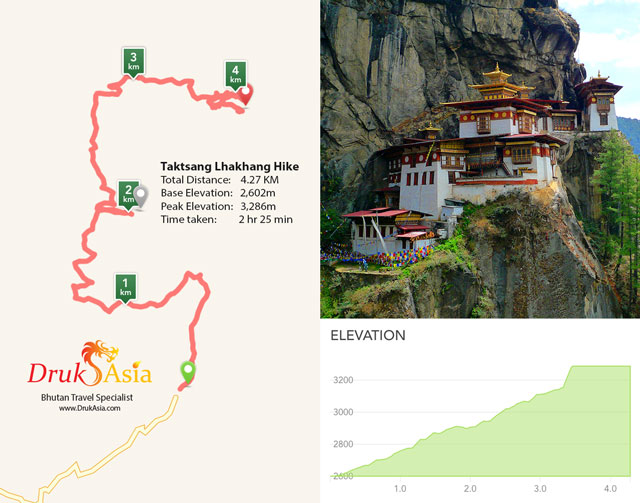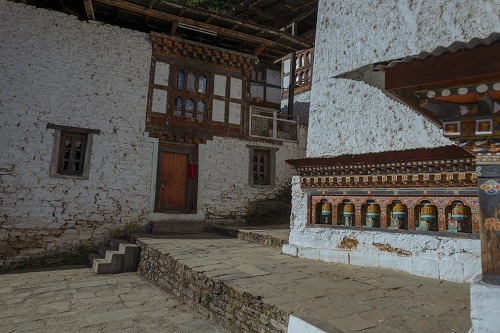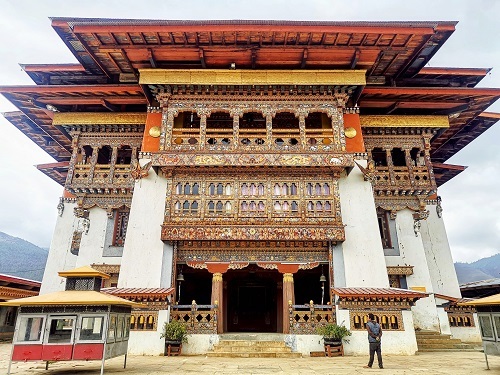1) Taktsang Monastery (Tiger’s Nest Monastery) - Paro
Perched precariously on a cliff side some 2,600 feet above the Paro Valley in the Kingdom of Bhutan is the legendary Taktsang Monastery, popularly known as the Tiger’s Nest. A trip to Bhutan is incomplete without visiting this distinguished icon of Bhutan, a monastery built in the 16th century.
Legend has it that Guru Padmasambhava, also commonly known as Guru Rinpoche, first arrived in Bhutan on a flying pregnant tigress in the 8th century and meditated in a cave on this very cliff for 3 years 3 months, 3 weeks and 3 days before subduing a local demon who has been terrorizing the local inhabitants of the nearby valley. The most revered Guru Rinpoche is also credited for introducing Buddhism to Bhutan and much of the Himalyan region. From Tiger’s Nest, Guru Rinpoche traversed Bhutan, quelled demons and brought long lasting peace to the valleys in the country.
The only way to visit Tiger’s Nest is by foot or by taking a mule up the steep climb to the half-way point. Depending on one’s fitness level, the trek up and down from Tiger’s Nest and the visit of the various temples can take anywhere from 3.5 hours up to 9 hours. It is advisable to start your trip as early as 6 a.m. to avoid the afternoon sun. The total distance to reach the temple is approximately 4.3 km with an elevation ascent of 650 metres.
From the starting point, up a steep climb until the 2 km mark is a cafeteria which is usually the lunch point for travellers. Travellers will then proceed another 2 km on a gentler slope to reach the second viewpoint. (https://goo.gl/maps/E4DrwXbtM8t7rXYM9) after which there will be concrete steps descending into a canyon, passing by a waterfall over a bridge, followed by the final ascending of 120 steps bringing one to the main entrance of Tiger’s Nest.
Along the way, you will walk past many colourful prayer flags that Bhutanese had strung up for the wind to bring compassion and blessings to all sentient beings. These colourful prayer flags called Lung Dhar, surface in five colors representing the five elements of nature: red for fire, blue for water, yellow for the earth, white for the sky and green for vegetation.

2) Chimi Lhakhang - Punakha
Chimi Lhakhang, also known as the Fertility Temple, is a popular Buddhist monastery in Bhutan. It is located near Sopsokha village in the Punakha District of Bhutan. Pilgrims and tourists have to trek for 20 minutes through the beautiful agricultural fields of rice and mustard to access the monastery. The monastery idyllically stands on a round hillock surrounded by scenic views. Built over half a millennium ago, it’s one of the oldest monasteries in Bhutan.
Thousands of pilgrims flock the temple annually especially couples who hope to have a child. Many stories of successful pregnancy have popped up from all over the world upon visiting Chimi Lhakhang. There is even a photo album with testimonials and letters sent by people who have received their fertility blessings in Chimi Lhakhang. Those with new-born children often visit the local Lama to get their children bestowed with resounding forenames. Most of the babies conceived after receiving blessings in the temple are named either Chimi or Kunley.
The temple is associated with the popular Tibetan saint, Drukpa Kunley aka Divine Madman. Drukpa Kunley’s ways of teaching Buddhism were shocking and bizarre, often with sexual overtones. The Lama is sometimes also referred to as ‘The Saint of 5,000 Women’ due to his truly bacchanal lifestyle full of women and wine. That’s the origin of the monastery’s alleged fertility inducing powers. Drukpa Kunley is also the very reason why you see those unusual phallus symbols throughout the country from handicraft shops to murals on the walls.
You can also visit the Lamas even if you are not looking for fertility or blessings of any kind − there’s a lot to learn about the culture and history of the Bhutanese at Chimi Lhakhang.
3) Kyichu Lhakhang - Paro
Kyichu Lhakhang location is in the north of Paro town. It is one of the oldest and most beautiful temples in Bhutan. It also goes by the names, Lho Kyerchu or Kyerchu, and it is considered to be the sacred Jewel of Bhutan. The temple was established by the Buddhist King Songstsen Gampo of Tibet in the 7th century to overcome the giant ogress that laid across Tibet and Himalayas who prevented the spread of Buddhism. The king is believed to have built the temple at the left foot of the enormous ogress. Kyichu Lhakhang was among the 108 temples that had been constructed to tame demoness. The temple's construction was said to have completed overnight.
Kyichu Lhakhang was initially small in size but after multiple visits over the years by the Buddhist saints, the temple expanded both in grandeur and size. In the 8th century, Guru Padmasambhava was believed to have visited the Kyichu Lhakhang and hidden a variety of treasures in the temple. Zhabdrung Ngawang Namgyal took over the temple in 1674. The temple was later reconstructed in the year 1836-1838 by the 25th Je Khenpo Sherab Gyaltshen. In 1968, a new structure of the temple was built and named Guru Lhakang. The extension was made by the Royal Queen Mother Ashi Kezang Choden Wangchuck. Other Buddhist Saints that visited Kyichu Lhakhang temple for prayers also created an impact by expanding the temple. The prominent Buddhist saints were Phajo Dugom Zhigpo, Lam Kha Nga and Guru Rinpoche and many more in the 8th century.
As one walks toward Kyichu Lhakhang, the environment is quiet and serene. You will find elderly pilgrims circumambulate the temple as they spin the prayer wheels. Inside the inner courtyard, there is a painting of the King named Gesar of Ling on the wall just near the entrance. The king was a renowned warrior in Tibet, and his epic poem is the longest in the world according to history.
Kyichu Lhakhang conceals the statue of Jowo Jamba originally from the 7th century. The icon is one of the greatest treasures of the valley. There is also another statue of Chenrezig outside the shrine that has 1000arms and 11 heads. There is the wooden floor that has grooves worn by the generations of prostrators. The main entrance door is coated with gold. Kyichu Lhakhang holds ancient relics and the floor of the main temple constructed with wood decorated with turquoise and other precious stones and gems.
The structure next to Kyichu Lhakhang is the Guru Lhakhang which consists of Kurukulla and 5-meter high statue of Guru Rinpoche holding an arrow made of flowers and a bow. Outside of the temple, there are two orange trees that bear fruits throughout the year. There are also monk houses, prayer wheels, Lenza script on tiny prayer wheels.
This old monastery is an incredible place for a visit in Bhutan.
4) Tango Monastery - Thimphu
Tango Goemba is a Buddhist monastery situated near the scenic Cheri Mountains in Bhutan. The name ‘Tango’ translates to ‘horse head’ in Bhutanese. The monastery is just 9 miles (14 km) north of the country’s capital city, Thimphu. Tango Goemba has a rich history and is one of the highest Buddhist learning centers in Bhutan. A vast majority of religious leaders and chief abbot, locally known as Je Khenpo, have gone through a nine-year training program at this particular monastery. After completing their training, the monks spend their retreat for 3 years, 3 months, and 3 days at the nearby Cheri Goemba
Tango Goemba has been in existence for hundreds of years. Tango Monastery was founded by Lama Gyalwa Lhanampa in the 13th century and built in its present form by Tenzin Rabgye, the 4th temporal ruler in 1688.
The Tango Goemba has a prominent main tower with recesses. The outside wall has a characteristic curved (semi-circular) wall. The structure is built in the style of a dzong (ancient fortress).. The site of the monastery used to be caves where saints performed miracles and other religious activities such as meditation. The monastery covers these caves, and you will find engraved slates behind the prayer wheels inside the monastery. Just outside the Tango Goemba is a courtyard with a gallery of illustrations of the leaders of the Drukpa Kagyupa lineage.
5) Cheri Monastery - Thimphu
Cheri Goemba monastery is the first Buddhist monastery located near Mt Cheri and borders Thimphu City, 14 kilometers to the north in Bhutan. Known for its famous hiking route, the Cheri monastery was built in 1620 by Ngawang Namgyal who spent more than three years in strict retreat and later dedicated the rest of his life in the monastery.
The hike/trek towards the monastery typically takes approximately one hour from the bridge for regular hikers but might be longer for non-hikers. The journey uphill may be a bit tiring, but the beautiful and breathtaking views from the top is totally worth the climb. The trail begins by crossing a nicely covered bridge that spans around the Wang Chhu and then heads steadily up to the monastery. The steep trail is wholly defined and scenic.
The monastery presently acts as a significant retreat and teaching center for the southern Tibetan Buddhism school. People from all walks of life come to tour the historic scenery while still taking some time to learn its history and the religious doctrines. The site is also known to have about 30 monks managing the religious activities and maintaining the monastery.
Cheri Goemba monastery is one of tourists’ favourite destinations, especially for those who are interested in learning more about Buddhism.

6) Khamsum Yulley Namgyal Chorten - Punakha
Khamsum Yulley Namgyal is a beautiful chorten located on a ridge at Kabesa Gewog in Punakha overlooking several villages. Standing regally on the hill above the Punakha valley, Khamsum Yulley Namgyal Chorten is a classic example of amazing traditions and architecture. This chorten is highly unique in Bhutan. It is neither designed for community worship nor monastic retreat like other Buddhist sites in Bhutan. Khamsum Yulley Namgyal Chorten was built by Queen Mother, Ashi Tshering Yangdon Wangchuck for warding off the negative forces and to bring peace and harmony for all the living beings in Bhutan and the world.
You need to hike for about an hour and cross a suspension bridge to reach Khamsum Yulley Namgyel Chorten. The climb up the hill is refreshing as the trail is surrounded by pine trees and stunning views. The trail can get a little steep towards the end. Once you reach the top, you will be able to see a lovely Bodhi tree, well-tended garden, two large prayer wheels, and the gorgeous little temple where the caretaker usually greets guests. The extensive rice fields and miniature chortens surrounding the temple offer a stunning view.

7) Kurjey Lhakhang - Bumthang
Kurjey Lhakhang is located in the Bumthang district. Nestled on the side of a hill, surrounded by 108 chorten walls, the complex houses three revered temples, namely: Guru Lhakhang, Sampa Lhundrup Lhakhang and Ka Gon Phor Sum Lhakhang.
During the 8th Century, Sendhu Raja, the king of Bumthang at that time, fell ill. He invited Guru Rinpoche who brought Buddhism to Bhutan to cure him. Guru Rinpoche found out that the king’s illness was caused by the malevolent actions of the local deities including the powerful Shelging Karpo. Having found the cause of the illness, Guru Rinpoche chased the deities into a cave, and meditated inside for three months. Guru Rinpoche then subdued the deities including the powerful Shelging Karpo and left his body imprint inside the cave, thus, giving the name Kurjey (Body Imprint). Beside the monastery is a tall cypress tree that is believed to have sprouted from the walking stick of Guru Rinpoche.
The first of the three temples, the Guru Lhakhang, is the oldest and was built in 1652. Tucked just below the caves is a figure of a snow lion with a jachung (also called garuda) above it, which represents the famous struggle between Guru Rinpoche (appearing as the garuda) and the local demon, Shelging Kharpo (as the snow lion). The statue of Shelging Kharpo inside the temple is hidden from view.
At the entrance to the lower-floor of Sangay Lhakhang, there is a small crawl-through rock passage. Bhutanese believe that by crawling through the narrow tunnel, you will leave your sins behind. Behind the statues of the three Buddhas is a secret passageway that is said to have once led to Tharpaling.
The second temple, the Sampa Lhundrup Lhakhang, was built by Ugyen Wangchuck, the first king of Bhutan, in 1990 when he was still penlop of Trongsa. It is built on the site of a cave containing a rock with the imprint of Guru's body and is therefore considered the most holy.
The third temple was built in 1984 by Ashi Kesang Wangchuck, the Queen Mother (Queen to the third king of Bhutan) under the guidance of Dilgo Khyentse Rinpoche.
The temple offers a spectacular view of the Bumthang valleys. From Kurjey Lhakhang, you can also explore the mesmerising apple orchards and dairy farms nearby.
8) Jambay Lhakhang - Bumthang
According to legend, this Jampa (Jambay) Temple or Temple of Maitreya in Bumthang is said to be one of the 108 temples built by the Tibetan King Songtsen Goenpo in a single day to pin down an ogress.
Similar to Kyichu Lhakhang, the tale of this temple starts with the effort of then-Tibetan-King Songtsen Gampo in building a series of temples throughout the Himalayas, each one was meant to help pinning down the ogress. Four were built to pin down her shoulders and hips; four more on the elbows and knees; and four to hold down her hands and feet. In the tale, it was believed that Jambay Lhakhang was built to pin down the left knee of the ogress.
The temple has been repaired and rebuilt several times over the years. Jambay Lhakhang is also the site for the popular Jambay Lhakhang Festival. During the five-day festival, the cham (maske-dances), including Tercham (a ritualistic naked dance on the fire) was performed.

9) Chumphu Nye Monastery - Paro
Chumphu Ney is located in Paro district, an hour drive from the capital city. Chumphu Nye is located on a secluded hilltop, detached from civilization. It is located at an elevation of 2800-2900 meters. The total walking distance is approximately 14 km and takes around 5-7 hours (round trip) to reach the monastery depending on your walking pace.
The trail is a bit longer compared to hiking up Tiger’s Nest, but it is not as physically exhausting. It is a pleasant hike through an enchanting forest, following a beautiful river until you reach a Stupa (Chorten). The last hundred meters incline up to the monastery is fairly steep. During spring season, you can see rhododendron flowers, mountain lilies and other rare floral species blooming beautifully.
The sacred site is popularly known for the floating statue of Dorji Phamo (Vajravarahi). This statue is inexplicably floating in the air which the visitors can witness upon reaching the monastery. Legend has it that when the statue was discovered from the lake, the statue was only about a foot tall. It is said that the statue magically grew to the present height and was placed in the Lhakhang as the main statue. The lake from where the statue was discovered is above the monastery.
The most enchanting thing about the statue is that it is not a man-made statue but Dorji Phamo herself who turned into this statue. It is believed that prayers and wishes made to the statue are bound to come true.
A further 10-minute walk behind the monastery leads to a small prayer-flag-draped waterfall and pool connected to Guru Rinpoche.
10) Gangtey Goenpa Monastery : Phobjikha valley
The Gangtey Goenpa monastery, or Gangteng Monastery is the main seat of the Pema Linpa tradition of the Nyingmapa school of Buddhism. Dating from the 17th century, it has superb views and guests usually visit the temple before embarking on the Gangtey Nature Trail.
Today, the Goemba is the seat for the 9th reincarnation of Terton (Treasure Revealer) Pema Lingpa. It is said that the migrating Black-Neck Cranes circumambulate the monastery before settling down in the valley during each winter. And also before they fly back to Tibet during summer. The Black Neck Cranes festival is also held in Gangtey Monastery on 11th November annually.
Gangtey Goenpa was established in 1613 by Pema Lingpa’s grandson on a spur in the Black Mountains called the Gangteng Sang Nga Chöling, which translates to “summit for the teaching of the dharma.” Local timber was used for the temple’s beams, doors, pillars, and windows.
Due to damage from an earthquake, the monastery was destroyed and subsequently restored between 2002 and 2008. Conservators worked to preserve the temple’s original detail with the addition of over 100 new pillars.
The monastery overlooks the spectacular scenery of Phobjikha valley.

